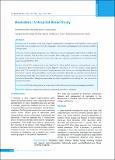Please use this identifier to cite or link to this item:
https://hdl.handle.net/20.500.14356/1670Full metadata record
| DC Field | Value | Language |
|---|---|---|
| dc.contributor.author | Limbu, Senchhema | - |
| dc.contributor.author | Dikshit, Parajeeta | - |
| dc.contributor.author | Gupta, Sujaya | - |
| dc.date.accessioned | 2023-05-18T05:39:46Z | - |
| dc.date.available | 2023-05-18T05:39:46Z | - |
| dc.date.issued | 2017 | - |
| dc.identifier.citation | LimbuS., DikshitP., & GuptaS. (2017). Mesiodens: A Hospital Based Study. Journal of Nepal Health Research Council, 15(2), 164-168. https://doi.org/10.33314/jnhrc.v15i2.934 | en_US |
| dc.identifier.issn | Print ISSN: 1727-5482; Online ISSN: 1999-6217 | - |
| dc.identifier.uri | http://103.69.126.140:8080/handle/20.500.14356/1670 | - |
| dc.description | Original Article | en_US |
| dc.description.abstract | Abstract Background: A mesiodens, is the most frequent supernumerary tooth present in the maxillary central incisor region. This study is conducted to know the radiographic characteristics and management of mesiodens in children visiting hospital. Methods: A cross-sectional retrospective data collection was done from hospital dental records of children who visited the institution from December 2015-December 2016. Radiographic characteristic of mesiodens including the number, shape, position, direction of crown and complication caused by mesiodens were recorded. Data were analyzed using IBM SPSS v.20.0. Results: Out of 1871 dental records, it was found that 40 children had 53 mesiodens, with male female ratio of 3:1 and most of them were discovered at 8 years. Majority of mesiodens, 54.7% were erupted, conical, palatally placed with 77.3% vertically directed crown.Complications associated with it were crowding followed by diastema and delayed eruption. Among 40 children, one had three mesiodens, eleven had two mesiodens and rest had one each. Radiographically fully formed tooth was seen in 29 mesiodens. Immature apex was seen in 38 central incisors associated with mesiodens. Management undertaken was simple/surgical extraction and only few cases were kept for periodic observation. Conclusions: Periodic radiographs act as an important tool for clinicians in detecting and managing mesiodens. Keywords: Children; complications; extraction; Kathmandu; mesiodens; radiograph. | en_US |
| dc.language.iso | en | en_US |
| dc.publisher | Nepal Health Research Council | en_US |
| dc.relation.ispartofseries | May-Aug, 2017;934 | - |
| dc.subject | Children | en_US |
| dc.subject | Complications | en_US |
| dc.subject | Extraction | en_US |
| dc.subject | Kathmandu | en_US |
| dc.title | Mesiodens: A Hospital Based Study | en_US |
| dc.type | Journal Article | en_US |
| Appears in Collections: | Vol 5 No 2 Issue 36 May-Aug 2017 | |
Files in This Item:
| File | Description | Size | Format | |
|---|---|---|---|---|
| 934-Article Text-2340-1-10-20170910.pdf | Fulltext Download | 191.33 kB | Adobe PDF |  View/Open |
Items in DSpace are protected by copyright, with all rights reserved, unless otherwise indicated.
